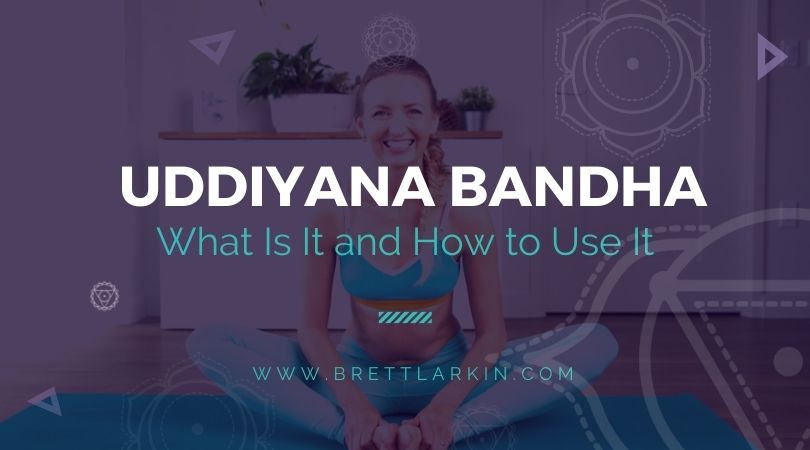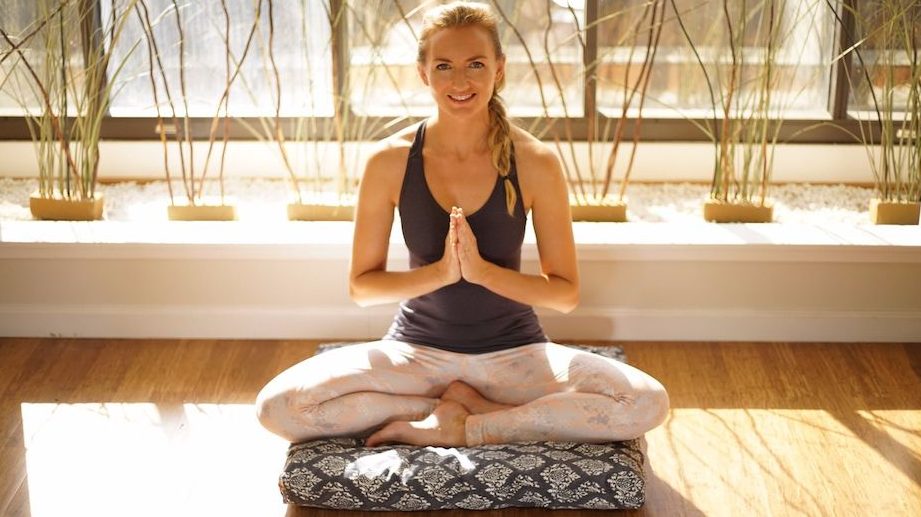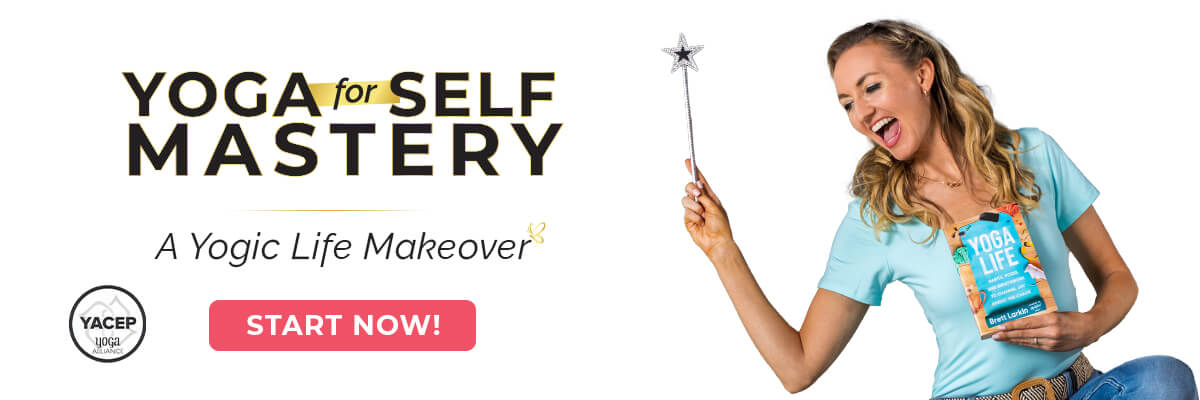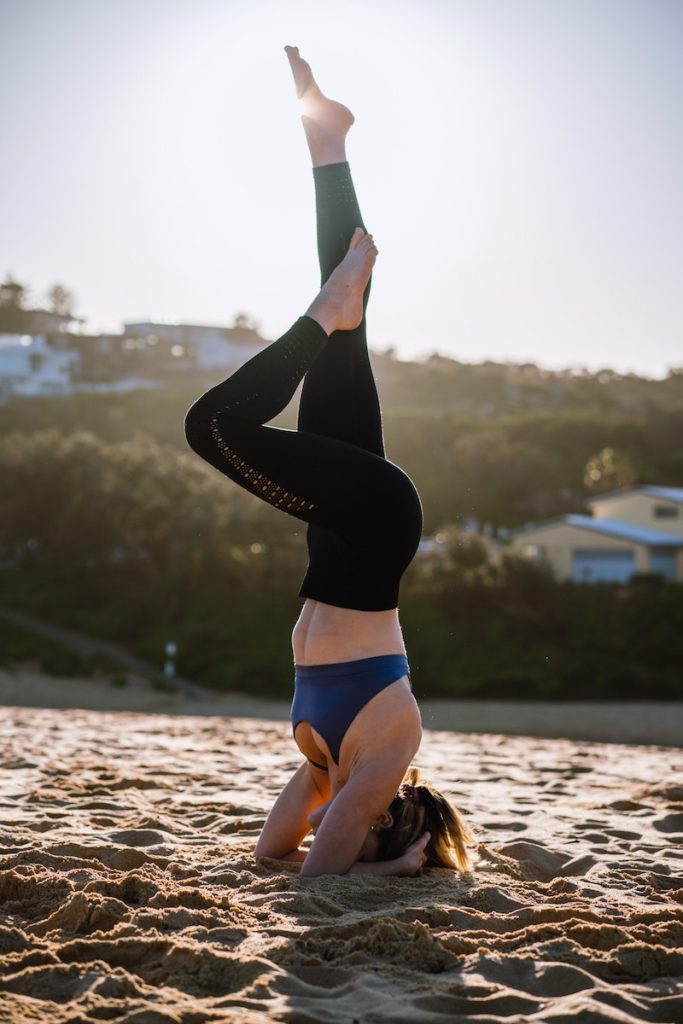
Have you ever dealt with stomach issues? I mean, who hasn’t right?
Well, imagine if your yoga practice could actually help your digestion along with generally strengthening your core. It can!
All with a little help from the uddiyana bandha. In this post, we’ll cover all the goods on what the uddiyana bandha is, why it’s useful, and how to practice it. Ready? Let’s jump in.
What is Uddiyana Bandha?
Uddiyana bandha is the abdominal lock also known as the upward flying lock or abdominal lift. It is the second of the three interior body “locks” that we yogis use in asana and pranayama practice to control the flow of energy (prana) in the body. It’s one of the most powerful locks. You suck your abdominal wall in and up at the end of an exhalation.
Practicing uddiyana bandha will result in a rising of energy, or prana, from the base of the spine to the head. This bandha is all about waking up all those dormant muscles in your pelvis and abdomen.
“It is the lion which conquers the elephant, death. Of all the bandhas, uddiyana is the best. Once it is mastered, liberation occurs spontaneously.” – Hatha Yoga Pradipika
Uddiyana Bandha Meaning
(oo-dee-YAH-nah BAHN-dah)
Uddiyana – meaning upward.
This describes the feeling of drawing the belly in and up that this bandha requires. You may also feel a rise in energy too.
Bandha – meaning binding, tying a bond, putting together, uniting, contracting.
Uddiyana bandha tones, massages and cleanses the abdominal organs and deep interior muscles.
The Physical Uddiyana Bandha
Uddiyana bandha is the active engagement of abdominal muscles. Yoga teachers often cue it as “draw your navel in towards your spine and up towards your rib cage”. You engage it when at the bottom of an exhale. This is when abdominal muscles are effectively engaged. When the core is engaged there is a natural upward flow of energy that gives the necessary support to the abdominal organs and spine.
When activating the Uddiyana Banda it tones the abdominal muscles but also creates space for the abdominal organs when the diaphragm is drawn upwards and under the rib cage. This also increases the efficiency of the diaphragm muscle, which ensures that dukka (stagnate energy/stale air) is massaged up and released through the exhale.
As well as supporting, toning and lifting our abdominal space, activating Uddiyana Bandha when practising particular postures in asana practice, such as arm balances and forearms stands can help you fly! (Well, at least make it feel like you’re flying.)
Uddiyana bandha is also sometimes taught separately as a pranayama practice, which is more in line with Iyengar’s approach.
The Subtle Uddiyana Bandha
On a more subtle level, uddiyana bandha activates the agni, or element of fire that is found at the navel. Strengthening this fire aids in purifying the body’s subtle channels, or nadis, aiding in an overall purification of the central channel, the sushumna nadi. One of the main goals of hatha yoga is to purify these nadis to allow prana to flow more freely and to radiate through your whole being.
The Practise of Uddiyana bandha stimulates and lifts the energy of the Apana Vayu (energy of the lower belly ) upwards and unites it with the Parana Vayu (energy of the heart) and Samana Vayu (energy of navel). This creates a unique flow of prana energy in our bodies.
Similar to the engagement and practice of Uddiyana bandha, Nauli is a cleansing ritual that yogis have used for thousands of years. In brief, it involves sucking up the contents of your abdomen and then massaging them by churning your abdominal muscles, all whilst holding your breath out.
For more information on nauli kriya check out the Uplifted article on Kriya Yoga here.
The Bandhas
Each lock, bandha, seals a specific part of the body and are often called energetic locks. The first lock is the mula bandha (root lock), the second is uddiyana bandha (abdominal lock) and the third is jalandhara bandha (throat lock). When all three bandhas are used together, it is called maha bandha, which means great lock. When you engage all the bandhas in your yoga practice it will help you to experience more freedom in your body.
Mula Bandha (root lock) – At the end of your exhalation, engage your pelvic floor muscles, but gently lifting them upwards. To begin with this action may feel quite forced, but with practice it will become more subtle to more of an energetic lift.
Jalandhara Bandha (throat lock) – This is used only during pranayama and meditation techniques, whilst performing breath retentions. We obviously don’t hold our breath during asanas (yoga postures), so there’s no need to perform Jalandhara bandha at any point in your physical practice.
The Uddiyana bandha links the other bandhas together, forming a central importance of energy flow in the body. When engaging the Uddiyana bandha, it’s best to practice the other bandhas too. You will learn more about this as you read along.
Read this Uplifted article on the bandhas to learn more.
Why Practice Uddiyana Bandha
The abdominal lock can help yogi’s connect to their center. Not only just massaging the abdominal organs and activating the third chakra, but breath retention helps to strengthen your lungs and your practice overall. It also helps to create space and generate power in your yoga practice.
Strengthens the abdominal muscles and diaphragm
By emptying the lungs and drawing the abdominal muscles in and up it gives a horizontal stretch to the diaphragm, which can assist in deep breathing and free up this muscle to help break chronic chest breathing patterns.
Massages abdominal organs, the solar plexus, and the heart and lungs
During Uddiyana bandha, pressure is created in the thorax causing the blood in the abdomen to be drawn into the heart. Simultaneously, fresh blood is drawn into the internal organs, where the organs are mechanically massaged. Massaging these organs results in a better function of these muscles.

Improves digestion and purifies the digestive tract of toxins
Activation of the Uddiyana bandha stimulates the inner agni, or digestive fire in the body, which is located around the navel. As a result, it improves digestion and purifies the toxins from the body.
Stimulates blood circulation in the abdomen and blood flow to the brain
As Uddiyana Bandha practice stimulates and increases blood circulation throughout the body and brain, the brain becomes healthier, making you feel younger physically and mentally.
It stimulates the vagus nerve by putting a little pressure on it, which strengthens and tones your parasympathetic nervous system, your relaxation response, which creates a calming and balancing effect on your nervous system. With practice you will experience more clarity in your thinking.
“Even an old person can become young when it is done regularly.”– Hatha Yoga Pradipika
How to Use Uddiyana Bandha in Yoga
In different styles of yoga, bandha work can be performed separately from asana practice, and sometimes even at the end of a yoga class. However, in Ashtanga yoga, the mula and uddiyana bandhas are meant to be used throughout the sequence in all of the postures.
Ideally you should perform Uddiyana Bandha at the beginning of your asana practice to stimulate the energy in the belly. Most importantly, remember to only practice it on an empty stomach after an exhalation, never before an inhalation.
Beginners: Engage the Abdominal Lock While Standing
It’s recommended that beginners start practising this bandha in Tadasana in order to learn Uddiyana bandha properly before trying it seated, which can feel more challenging to practice.
Here’s how to do it:
- Begin in a standing position and stand with your feet slightly apart and your eyes open
- Bend your knees slightly and bring your palms to your thighs, just above your knees. Keep your arms straight, shoulders relaxed.
- Take a deep inhalation through your nose, then quickly exhale through pursed lips. Engage your abdominal muscles to fully push as much air out of your lungs as possible, then relax your abdomen.
- Then engage uddiyana bandha by practicing a false inhale, where you expand your rib cage as if you were inhaling, but don’t actually inhale. The expansion of the rib cage (without the inhalation) hollows the belly and sucks the abdominal muscles up, creating an abdominal cavity.
- Hold the breath for five to 15 seconds. Then slowly release the abdomen and inhale normally. Take a few rounds of natural breathing, before repeating for three to 10 rounds, depending on your capacity.
Intermediates & Beyond: Practice Uddiyana Bandha Seated

When you have practiced with Uddiyana bandha standing for some time and can execute it well for a few rounds, then you may be ready to advance your practice in a seated position.
Here’s how to do it:
- Come into a comfortable sukhasana cross-legged seated position with palms facing downwards on the knees
- Close your eyes and breathe slowly
- Begin to engage Mula bandha by drawing up the pelvic floor
- Once you have Mula bandha engaged, quickly exhale all of the breath out through the nose, lean forwards and engage your abdominal muscles to strongly pull the belly in and up under the rib cage, performing your mock inhalation
- Try to also take Jhalandara bandha at this point
- Hold the breath as you hold the abdominal lock for as long as comfortable with all the bandhas active
- To release, soften the abdomen, lean back and very slowly take a breath in through the nose
- Take a few slow deep breaths in and out and let your breath return to normal before repeating. Begin with practicing three rounds and then you can slowly increase it to up to ten rounds.
Float Into Your Inversions with the Upward Flying Lock
Without engaging the bandhas, the body is simply not able to support its own weight on our arms, no matter how hard we press down through the hands.
For movements such as Downward dog into standing forward fold and standing forward fold into chaturanaga, all require a level of engagement of the Uddiyana bandha and Mula bandha.
Imagine that there is a piece of thread attached from your belly button to your pelvic floor and when you want to ‘fly’, draw the navel to spine and at the same time engage the pelvic floor at the bottom of an exhale (when abdominal muscles are most effectively engaged). This will encourage an upward physical lift from the inside out, allowing you to float and feel weightless, eventually!
Uddiyana Bandha Contraindications
Uddiyana bandha is not suitable during pregnancy, for people with high blood pressure, heart conditions, risk of stroke or thrombosis, glaucoma, an internal ulcer or any condition that may be aggravated by breath retention and increased internal pressure.
Next Steps
- Take my History of Yoga Course to learn all about yogic principles and how they are applied to daily life!
- Order my Yoga Life book for a practical guide to applying yogic principles to your life and constitution.
- Check out my Yoga Philosophy knowledge hub for more inspiring content
- Join Uplifted for exclusive content that you can access right from the app. Take a deep dive into your practice with me this year!
Experience 3 Training Videos from Inside My 200-Hour Online YTT

YOU MIGHT ALSO LIKE
- Uddiyana Bandha: Tapping Into Your Deep Core
- 4 Reasons Hasta Bandha Is Essential To Your Yoga Practice
- What is Mula Bandha and How to Practice It
- Jalandhara Bandha: 4 Reasons Yogis of All Levels Should Practice It
- Pada Bandha: Your #1 Secret to Happy Feet
- The 6 Ancient Yoga Bandhas (And How To Engage Them)
Learn how to do 11 of the most popular yoga poses correctly. Free video + PDF download.












